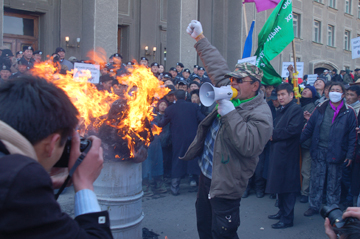Practical Guide for media practitioners in Mongolia
08-09-2006 (Beijing)

B. Altantuya, Amnesty Mongolia,
introducing the Guidelines
© C. Whetham,
Amnesty International Mongolia
“A biased comment that knowingly distorts the truth harms the spirit and dignity of the journalist profession”, states one of the principles of the Nihon Shimbun Kyokai journalists’ charter. Many journalists in Mongolia agree with this principle. But what if pursuing the noble goal of telling the truth, the journalist himself or herself runs a high risk of being hurt?
On 6 July 2006, B. Tsevegmid, the editor of Nomin television station, northern Mongolian province of Orkhon, was beaten at the entrance of her building and had to be hospitalized for treatment. Before being attacked she had received many threats by telephone concerning an investigative television program, "Forbidden to watch," which covered the Erdenet mining industry employees' privatization vouchers.
Responding to numerous cases of threats to physical and psychological integrity of journalists, the Amnesty International Mongolia translated the “Practical Guide for Journalists” into Mongolian and published in one thousand copies for free distribution among the Mongolian media practitioners. The Practical Guide for Journalists produced jointly by UNESCO and Reporters without Borders in 2002, goes long way to tackle the issue of both defending press freedom and the physical safety of journalists. From the SOS Press hotline to mines and booby-traps to guidelines and procedures for investigating infringements of press freedom, the Guide can help journalists to find their way through dangerous situations.
“Most journalists do not have practical knowledge of how to protect themselves if they are at risk from violation of their rights; they also have little knowledge of their basic human rights. Journalists who were under arrest or in detention did not know whom to contact to protect their rights,” says Jargal Purev, journalist and board member of Amnesty International Mongolia. Established in 2003, the Amnesty International Mongolia is committed to human rights issues in Mongolian media. It expects that translation and publication of the Guide will push the public debate in favour of the media policy on human rights in Mongolia.
According to Ms. Jargal, another important achievement of this project is the dissemination of knowledge on international standards of journalism to Mongolian media practitioners: “There are several international rules and procedures for media organizations and workers translated and used in Mongolia, but none of them gives information on how to investigate press freedom violation or to protect journalists and media organizations from violation.”
At the press-conference where Amnesty International Mongolia introduced the Guide to journalists, Mr. G. Guchin-Yos, Program Director of C1 TV channel: “Thanks for implementation of this project that allowed us to study internationally standardized rules and procedures. We always think that we know and we can do by ourselves. But from the introduction of the book, it is clear now that there are many important practical advices which we never heard about.”
The Guide will be distributed by Amnesty to TV and radio stations, newspapers, journalist departments of Universities, media NGOs and Internet providers.
Responding to numerous cases of threats to physical and psychological integrity of journalists, the Amnesty International Mongolia translated the “Practical Guide for Journalists” into Mongolian and published in one thousand copies for free distribution among the Mongolian media practitioners. The Practical Guide for Journalists produced jointly by UNESCO and Reporters without Borders in 2002, goes long way to tackle the issue of both defending press freedom and the physical safety of journalists. From the SOS Press hotline to mines and booby-traps to guidelines and procedures for investigating infringements of press freedom, the Guide can help journalists to find their way through dangerous situations.
“Most journalists do not have practical knowledge of how to protect themselves if they are at risk from violation of their rights; they also have little knowledge of their basic human rights. Journalists who were under arrest or in detention did not know whom to contact to protect their rights,” says Jargal Purev, journalist and board member of Amnesty International Mongolia. Established in 2003, the Amnesty International Mongolia is committed to human rights issues in Mongolian media. It expects that translation and publication of the Guide will push the public debate in favour of the media policy on human rights in Mongolia.
According to Ms. Jargal, another important achievement of this project is the dissemination of knowledge on international standards of journalism to Mongolian media practitioners: “There are several international rules and procedures for media organizations and workers translated and used in Mongolia, but none of them gives information on how to investigate press freedom violation or to protect journalists and media organizations from violation.”
At the press-conference where Amnesty International Mongolia introduced the Guide to journalists, Mr. G. Guchin-Yos, Program Director of C1 TV channel: “Thanks for implementation of this project that allowed us to study internationally standardized rules and procedures. We always think that we know and we can do by ourselves. But from the introduction of the book, it is clear now that there are many important practical advices which we never heard about.”
The Guide will be distributed by Amnesty to TV and radio stations, newspapers, journalist departments of Universities, media NGOs and Internet providers.

As public dissatisfaction with authorities mounts, journalists are increasingly in the front lines.
© C. Whetham, Amnesty International Mongolia
Related themes/countries
· Mongolia
· Training of Media Professionals: News Archives 2006
· Freedom of Expression: News Archives 2006
Share this story:
Contact information
- UNESCO
Source














